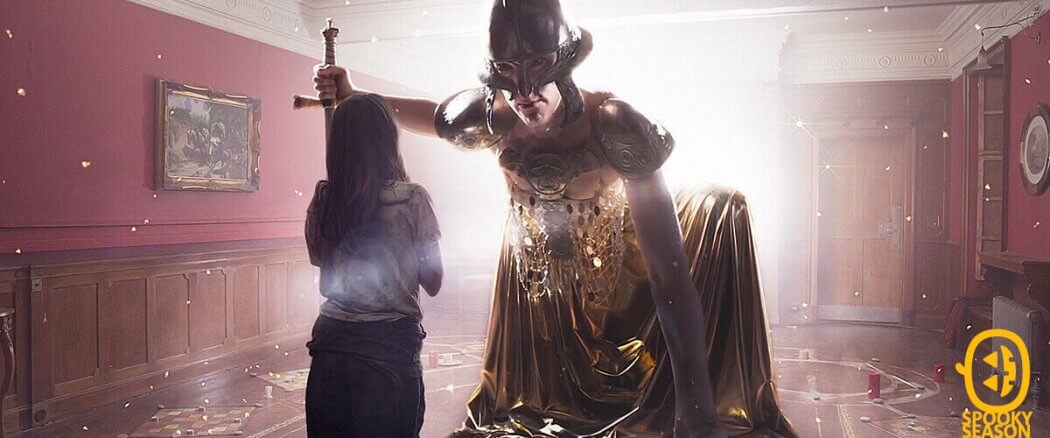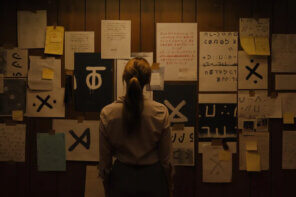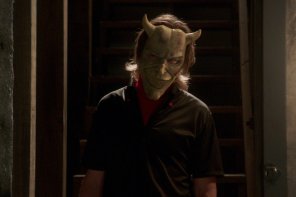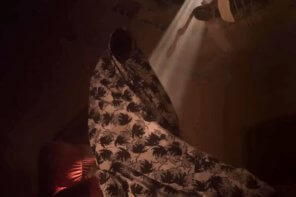If occult magic had real power, what would it take to achieve it? If humanity could summon and control transcendent spirits, would the process be painless? Empowering? Academic? A Dark Song, an Irish independent film from first-time writer/director Liam Gavin, speculates quite the opposite. By turns intense, exhausting, brutal and horrifying, the filmic magic of A Dark Song is in the growing dread of its protagonists as they perform rites meant to conjure up angelic powers in an abandoned mansion. Isolated in the hills of a perpetually cloudy Ireland, frustrated sorcerer Joseph Solomon (Steve Oram) and grieving mother Sophia Howard (Catherine Walker) move through ritual after ritual with a grim determination. Candles are lit, symbols are drawn on floors and bodies, blood is drunk, and the line between normal and paranormal blurs and breaks. If “creepy, supernatural character study” sounds like the Netflix category of your dreams, this film is worth a watch.
 In some “christian homes,” movies with occult themes are forbidden fruit. When I was in middle school I remember watching a movie with a sex scene in it at a friend’s house that was quickly hand-waved away by his parents. Ditto ultra-violence (Robocop, if you must know). But any suggestion that we watch a movie with ghosts or demons was met with pearl-clutching and a 10-minute sermon. Also I was not allowed to watch the Dungeon’s and Dragons Saturday morning cartoon in the 80s and I’m still salty about it. A Dark Song in this sense is the ultimate taboo. It goes out of its way to portray occult magic with as much realism as possible. There’s nothing light-hearted about playing with dark powers. Oram’s sorcerer is no grinning, confident Stephen Strange. There are no quips. There’s nothing that makes magic seem “cool”. The art direction is minimal – a lot of heavy shadows and drab colors. The house, as large and rambling as it is, becomes claustrophobic. Our leads aren’t “likable” in the way sexy young witches and wizards are usually portrayed. Casting spells is a grind that must be repeated over and over until the attention of Sophie Howard’s guardian angel can be acquired. The functional/mechanical aspects of rituals is emphasized, and the deadly spiritual risk that one wrong move may draw the attention of Other Beings is real. Howard’s motivation seems simple at first: she’s petitioning an angel to hear the voice of a dead loved one. But later her real purpose is revealed: revenge. She longs to violently destroy the occultists who (apparently) abducted and killed her young son.
In some “christian homes,” movies with occult themes are forbidden fruit. When I was in middle school I remember watching a movie with a sex scene in it at a friend’s house that was quickly hand-waved away by his parents. Ditto ultra-violence (Robocop, if you must know). But any suggestion that we watch a movie with ghosts or demons was met with pearl-clutching and a 10-minute sermon. Also I was not allowed to watch the Dungeon’s and Dragons Saturday morning cartoon in the 80s and I’m still salty about it. A Dark Song in this sense is the ultimate taboo. It goes out of its way to portray occult magic with as much realism as possible. There’s nothing light-hearted about playing with dark powers. Oram’s sorcerer is no grinning, confident Stephen Strange. There are no quips. There’s nothing that makes magic seem “cool”. The art direction is minimal – a lot of heavy shadows and drab colors. The house, as large and rambling as it is, becomes claustrophobic. Our leads aren’t “likable” in the way sexy young witches and wizards are usually portrayed. Casting spells is a grind that must be repeated over and over until the attention of Sophie Howard’s guardian angel can be acquired. The functional/mechanical aspects of rituals is emphasized, and the deadly spiritual risk that one wrong move may draw the attention of Other Beings is real. Howard’s motivation seems simple at first: she’s petitioning an angel to hear the voice of a dead loved one. But later her real purpose is revealed: revenge. She longs to violently destroy the occultists who (apparently) abducted and killed her young son.
The mythology of A Dark Song is pluralistic: multi-lingual chanting, naming gods from across cultures (Jesus is mentioned in a ritual as one of many protectors), writing in characters from many alphabets. Howard (and the audience) is never sure if any of this is real, or if Solomon is just an angry pervert with a purple robe and some chalk. He seems to be certain that the spell is working. Signs like animals suddenly appearing and mysterious knocking are confirmations that Something Is Happening. There are occasional jump scares, but much of the film is a stationary camera staring into a dark corner with Ray Harman’s wonderfully tense soundtrack for company. I wavered between “I hope this works” to “I sure hope this doesn’t work.” For the bulk of A Dark Song, unseen horror is the name of the game. Things happen just out of our line of sight, or just out of earshot. In the last act however, things take a surprising turn. The principalities and powers have finally noticed Howard and Solomon, and they are not pleased.
 Just when all hope seems lost, Sophia is rescued by her guardian angel. The spell has worked and Sophia is granted her one request. The final scene elevates A Dark Song past a Hellraiser-style horror film and pushes it into new territories. There is a twist – instead of asking for the torturous deaths of her son’s murderers – Sophia asks for the ability to forgive his killers and presumably herself. The angel scene is powerful, not just because she is literally saved from hell, but because the design of the angel is so unexpected. It fills the room with its immense size and golden light. It is arrayed for battle in sword and armor, like a Renaissance painting come to life. As it silently speaks the house trembles. Sophia’s redemption lies in forgiveness and mercy, the violence harbored toward those who wronged her is revealed for what it is – evil masquerading as justice.
Just when all hope seems lost, Sophia is rescued by her guardian angel. The spell has worked and Sophia is granted her one request. The final scene elevates A Dark Song past a Hellraiser-style horror film and pushes it into new territories. There is a twist – instead of asking for the torturous deaths of her son’s murderers – Sophia asks for the ability to forgive his killers and presumably herself. The angel scene is powerful, not just because she is literally saved from hell, but because the design of the angel is so unexpected. It fills the room with its immense size and golden light. It is arrayed for battle in sword and armor, like a Renaissance painting come to life. As it silently speaks the house trembles. Sophia’s redemption lies in forgiveness and mercy, the violence harbored toward those who wronged her is revealed for what it is – evil masquerading as justice.
The reason I am “for” supernatural stories, whether it’s ghosts or demons or monsters or fairies, is because they pull back the veneer of our “natural” stories: scientific knowledge, technology, civilization, progress. These mythologies try and convince us we’re no longer an enchanted people. But we are and always will be. As one writer put it recently, “stories that leave us troubled and uncertain are the ones we can take with us [into exile]” because they make us “brave and hopeful.” Halloween has always been one of my favorite celebrations because of this. It’s good to remember we’re still afraid of the dark, it sets us free to remember there is a light brighter than the darkest song.





